bunzlau
now browsing by tag
antique
beer
blue
ceramic
character
eagle
early
edition
etched
faience
figural
german
germany
gerz
gift
glass
glazed
hand
king
large
lidded
limited
liter
lithophane
made
mettlach
military
munich
oktoberfest
original
painted
pewter
porcelain
rare
regimental
relief
remy
scene
stein
steins
stoneware
tall
tankard
vintage
westerwald
Antique Early German Brown Earthenware Beer Stein Melonenkrug Bunzlau c. 1750

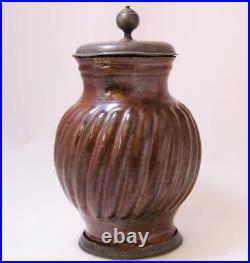
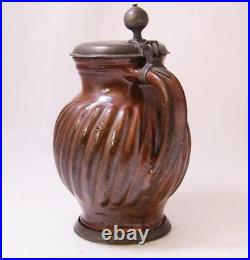
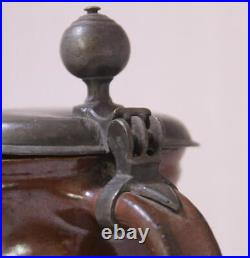
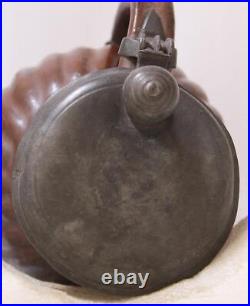
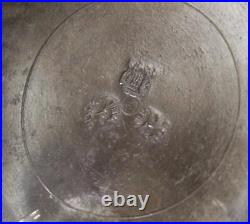
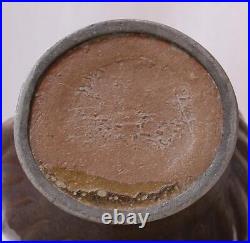
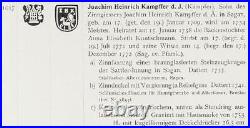

Antique Early German Brown Earthenware Beer Stein Melonenkrug Bunzlau c. Hello, my dear customers! I will be out of the country from September 2nd to September 12th. Please keep this in mind! Presented is a rare example of early German pottery. This high-fired earthenware brown-glazed beer stein was made in Bunzlau – a town in Lower Silesia in the mid-1700s. In fact, all the pottery production from small towns in Lower Silesia is called “Bunzlau” Every German town and every region that was known to make pottery had its own unique technologies and trade secrets. That’s why we can determine where a particular piece was made based on the appearance, style, and type of the pottery. The steins of this kind were called “Melonenkrug” or “Melon-shaped steins” because of their round shape and vertical or diagonal ribs. These ribs were made by hand from the inside initially and later with the help of a special instrument. The lead-based brown glaze was typical for Bunzlau. “Melon-shaped steins faded out of fashion after 1750″, -writes Beatrix Adler in her book “Early Stoneware Steins” based on Les Paul’s collection. “The last date we can find on a pewter mount is 1757″. The pewter lid is dome-shaped with a hollow ball thumblift. The inside of the lid is stamped with pewter marks that belong to Joahim Heinrick Kampffer, a pewterer in the town of Sagan in Lower Silesia, now Zagan in Poland. He was active in mid-1700s and died in 1771. The stein is large and impressive – it stands 9 tall to the top of the thumblif, with approx. 1.5 Liter capacity. A very similar, almost identical stein is featured in Gery Kirsner’s “The Beer Stein Book” on page 40. The stein is in good condition, the appearance is excellent. There are some small chips on the upper lip covered by the lid but no large chips, cracks, or repairs. The lid has the hinge rings broken – it could be separated from the stein. This is a very good condition overall for a stein over 250 years old (see pics). It is very impressive and elegant and a true historical piece that carries over 200 years of both culture and technology. I guarantee the authenticity. Condition: Minor chips, the hinge has broken rings. Get Supersized Images & Free Image Hosting. Attention Sellers – Get Templates Image Hosting, Scheduling at Auctiva. Com. Track Page Views With.

Antique Early German Brown Earthenware Beer Stein Birnkrug Bunzlau dat. 1781

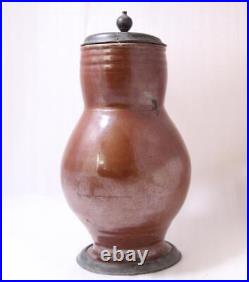
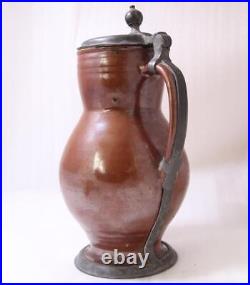
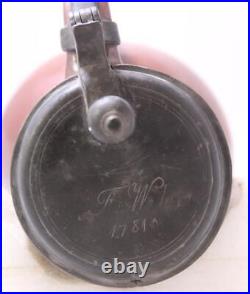
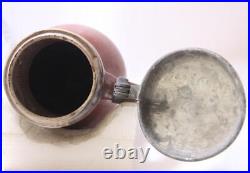
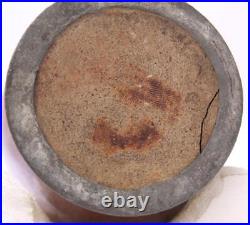

Antique Early German Brown Earthenware Beer Stein Birnkrug Bunzlau dated 1781. Description: In the next few days I will be posting a small collection of three very similar Bunzlau beer steins that differ only in size. This one is the middle in size. Presented is a rare example of early German pottery made around the late-1700s. This high-fired earthenware brown-glazed beer stein was made in Bunzlau – a town in Lower Silesia. In fact, all the pottery production from small towns in Lower Silesia is called “Bunzlau” Every German region and almost every town that was known to make pottery had its own unique technologies and trade secrets. That’s why we can determine where a particular piece was made based on the appearance, style, and type of the pottery. The steins of this kind were called “Birnkruge” or “Pear-shaped steins” because of their pear-like shape They are glazed with glossy lead-based chocolate-brown glaze that was typical (and unique) for Bunzlau. The pewter lid is dome-shaped with a hollow ball thumblift. The pewter foot ring was intended to support the pedestal from chipping, the handle strap supports the handle and is very typical for Bunzlau Birnkruge. The lid is engraved with the original owner’s initials: F. Please note – this is the original engraving, stein was made in 1781 or a little earlier. The stein is large and impressive – it stands 12 tall to the top of the thumblift, with approx. Over 2 Liter capacity. A very similar but smaller stein is featured in Gary Kirsner’s “The Beer Stein Book” on page 40 pic. The stein is in almost excellent condition, and the appearance is great. There is a small crack in the pedestal that is secured by the foot ring. Otherwise there are no cracks or chips or any other repairs. Some age-related glaze and pewter wear only. This is a fantastic condition overall for a stein over 200 years old. It is very impressive and elegant and a true historical piece that carries almost 250 years of both culture and technology. Condition: Excellent with small chip at the foot secured by foot ring. Get images that make Supersized seem small. Track Page Views With.

Antique Early German Brown Earthenware Beer Stein Birnkrug Bunzlau c. 1780s

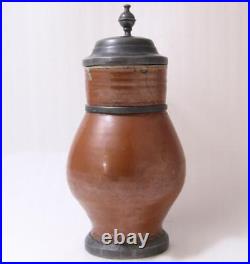
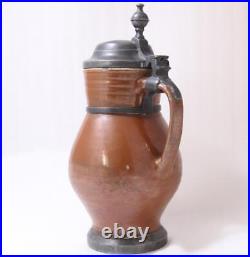
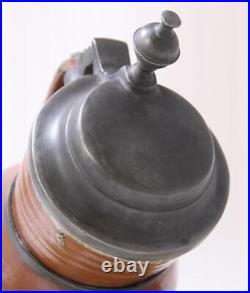

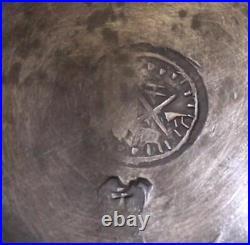
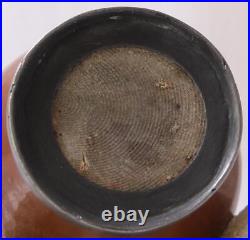

Antique Early German Brown Earthenware Beer Stein Birnkrug Bunzlau c. Description: In the next few days I will be posting a small collection of three very similar Bunzlau beer steins that differ only in size. This one is the smaller one but still quite large. Presented is a rare example of early German pottery made around the late-1700s. This high-fired earthenware brown-glazed beer stein was made in Bunzlau – a town in Lower Silesia. In fact, all the pottery production from small towns in Lower Silesia is called “Bunzlau” – there are no distinctive features to differentiate them. Every German region (and almost every town) that was known to make pottery had its own unique technologies and trade secrets. That’s why we can determine where a particular piece was made based on the appearance, style, and type of the pottery. The steins of this kind were called “Birnkruge” or “Pear-shaped steins” because of their pear-like shape They are glazed with glossy lead-based chocolate-brown glaze that was typical (and unique) for Bunzlau. The pewter lid is dome-shaped with a hollow ball thumblift. The pewter foot ring was intended to support the pedestal from chipping, the neck ring supports the neck and is very typical for Bunzlau Birnkruge. The lid is stamped with pewterer hallmarks but they are too illegible to be recognized. The stein is large and impressive – it stands 11 tall to the top of the thumblift, with approx. Over 1.5 Liter capacity. A very similar but smaller stein is featured in Gary Kirsner’s “The Beer Stein Book” on page 40 pic. The stein is in almost excellent condition, and the appearance is great. There is a small crack in the neck that is secured by the net ring. Otherwise there are no cracks or chips or any other repairs. Some age-related glaze and pewter wear only. It is very impressive and elegant and a true historical piece that carries almost 250 years of both culture and technology. Condition: Excellent with a small crack at the neck secured by the neck ring. Get Supersized Images & Free Image Hosting. Attention Sellers – Get Templates Image Hosting, Scheduling at Auctiva. Com. Track Page Views With.

Antique Large Early German Brown Earthenware Beer Stein Birnkrug Bunzlau c. 1780s

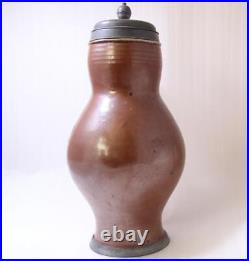
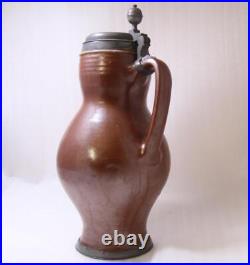
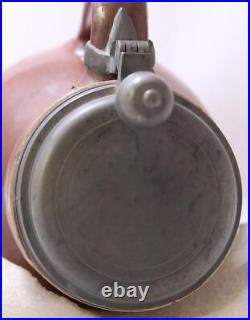
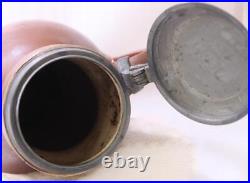
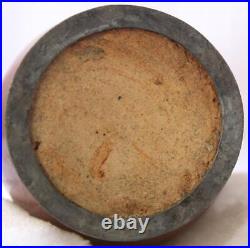

Antique Large Early German Brown Earthenware Beer Stein Birnkrug Bunzlau c. Description: This is the fourth of the small collection of Bunzlau steins I post – it is the largest by far. Presented is a rare example of early German pottery made around the late-1700s. This high-fired earthenware brown-glazed beer stein was made in Bunzlau – a town in Lower Silesia. In fact, all the pottery production from small towns in Lower Silesia is called “Bunzlau” – there are no distinctive features to differentiate them. Every German region (and almost every town) that was known to make pottery had its own unique technologies and trade secrets. That’s why we can determine where a particular piece was made based on the appearance, style, and type of the pottery. The steins of this kind were called “Birnkruge” or “Pear-shaped steins” because of their pear-like shape They are glazed with glossy lead-based chocolate-brown glaze that was typical (and unique) for Bunzlau. The pewter lid is dome-shaped with a hollow ball thumblift. The pewter foot and lip rings were intended to support the pedestal and the neck from chipping and cracking. The stein is very large and impressive – it stands 15 tall to the top of the thumblift, with a 3L capacity. A very similar but smaller stein is featured in Gary Kirsner’s “The Beer Stein Book” on page 40 pic. The stein is in excellent condition, and the appearance is great. There is no cracks or chips or any other repairs. Some age-related glaze and pewter wear only. You can see some glaze crazing on the inside but it is not cracks since they don’t show on the outside. It is very impressive and elegant and a true historical piece that carries almost 250 years of both culture and technology. Please check my store. Condition: Excellent with a small crack at the neck secured by the neck ring. Get images that make Supersized seem small. Track Page Views With.

Large Antique German Brown Earthenware Beer Stein Melonenkrug Bunzlau c. 1750s

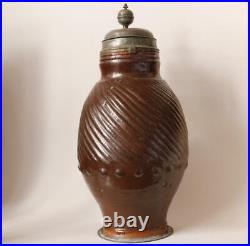
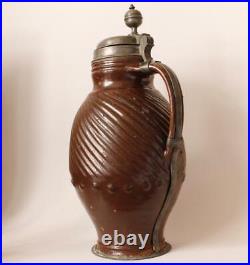
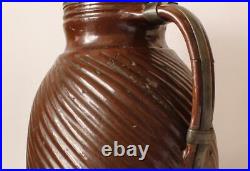
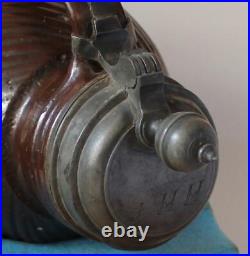
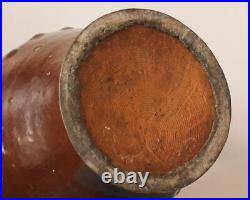

Antique Early German Brown Earthenware Beer Stein Melonenkrug Bunzlau c. Description: Presented is a rare example of early German pottery made around mid-1700s. This high-fired earthenware brown-glazed beer stein was made in Bunzlau – the town in Lower Silesia. In fact, all the pottery production from small towns in Lower Silesia is called “Bunzlau”. Every German town and every region that was known to make pottery had it’s own unique technologies and trade secrets. That’s why we can determine where a particular piece was made based on the appearance, style and the type of the pottery. The steins of this kind were called “Melonenkrug” or “Melon-shaped stein” because of round shape and vertical or diagonal ribs. These ribs were made by hand from inside initially and later with a help of a special instrument. The lead-based brown glaze was typical for Bunzlau. The pewter lid is dome-shaped with hollow ball thumblift. It is engraved with initials F. The pewter lip ring and neck ring were intended to support the neck and is very typical for Bunzlau Melonenkruge. The stein is large and impressive – it stands 15 tall to the top of the thumblif, with approx. A very similar but smaller stein is featured in Gery Kirsner’s “The Beer Stein Book” on page 40. The stein is in a good condition, the appearance is excellent. The handle was broken some time ago and glued back together, supported by the pewter handle strap. Otherwise no issues – no cracks or chips or any other repairs. Some age-related glaze and pewter wear only. This is a very good condition overall for a stein over 250 years old. It is very impressive and elegant and a true historical piece that carries over 200 years of both culture and technology. I guarantee the authencity. Track Page Views With.

Large Antique German Brown Earthenware Beer Stein Melonenkrug Bunzlau c. 1750s

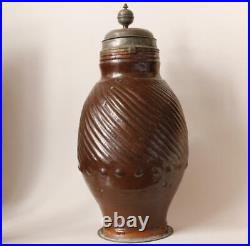
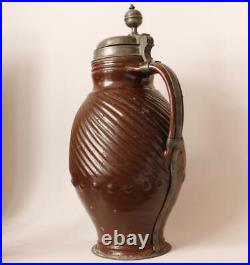
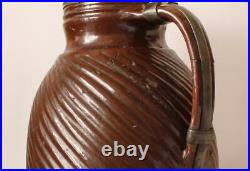
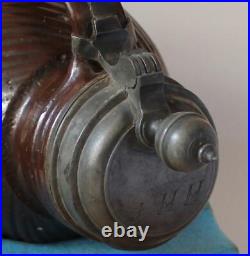


Antique Early German Brown Earthenware Beer Stein Melonenkrug Bunzlau c. Description: Presented is a rare example of early German pottery made around mid-1700s. This high-fired earthenware brown-glazed beer stein was made in Bunzlau – the town in Lower Silesia. In fact, all the pottery production from small towns in Lower Silesia is called “Bunzlau”. Every German town and every region that was known to make pottery had it’s own unique technologies and trade secrets. That’s why we can determine where a particular piece was made based on the appearance, style and the type of the pottery. The steins of this kind were called “Melonenkrug” or “Melon-shaped stein” because of round shape and vertical or diagonal ribs. These ribs were made by hand from inside initially and later with a help of a special instrument. The lead-based brown glaze was typical for Bunzlau. The pewter lid is dome-shaped with hollow ball thumblift. It is engraved with initials F. The pewter lip ring and neck ring were intended to support the neck and is very typical for Bunzlau Melonenkruge. The stein is large and impressive – it stands 15 tall to the top of the thumblif, with approx. A very similar but smaller stein is featured in Gery Kirsner’s “The Beer Stein Book” on page 40. The stein is in a good condition, the appearance is excellent. The handle was broken some time ago and glued back together, supported by the pewter handle strap. Otherwise no issues – no cracks or chips or any other repairs. Some age-related glaze and pewter wear only. This is a very good condition overall for a stein over 250 years old. It is very impressive and elegant and a true historical piece that carries over 200 years of both culture and technology. I guarantee the authencity. This item is in the category “Collectibles\Breweriana, Beer\Drinkware, Steins\Lidded Steins\Germany”. The seller is “beer-stein” and is located in this country: US. This item can be shipped worldwide.

 D5 Creation
D5 Creation